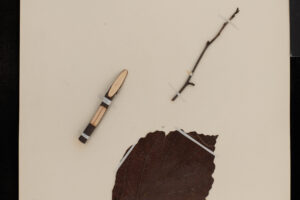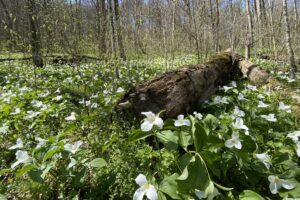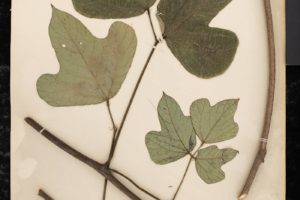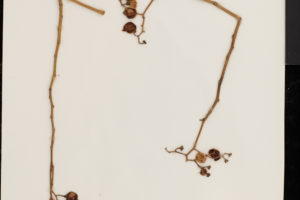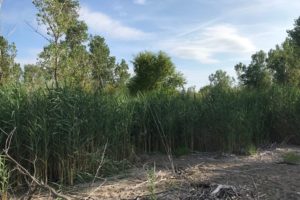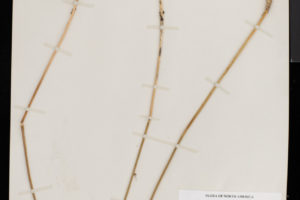Associate Curator, Botany

Biography
Mason Heberling is the associate curator in the Section of Botany at Carnegie Museum of Natural History. Heberling received his Ph.D. from Syracuse University in Biology in 2015, and a B.S. from Penn State in Biology (Ecology) in 2010. He conducted postdoctoral research through the University of Tennessee Knoxville in the Department of Ecology and Evolutionary Biology and in the Section of Botany at Carnegie Museum of Natural History.
Heberling is a plant ecologist and botanist whose research explores plant functional strategies in deciduous forest understories, especially in the context of environmental change. Much of his current research focuses on the ecology
and evolution of non-native, invasive plants in the eastern United States, the ecophysiological strategies of the herbaceous layer in deciduous forests, and the impacts of climate change on the timing of leafing out and flowering in temperate deciduous forests.
Heberling is particularly interested in innovative uses for natural history collections and rethinking how we collect. He has strong and diverse interests in the longstanding and emerging roles of herbaria in the Anthropocene. He is part of a long-term collaborative project in the Section of Botany to revisit sites throughout Western Pennsylvania that were historically visited by previous museum curators and botanists to study changes in our local flora and species’ responses to climate change.

Collected On This Day: Witch Hazel, January 1923
by Mason Heberling This specimen of common witch hazel (Hamamelis virginiana) was collected in January 1923 in Beaver County, Pennsylvania “East of …
Collected On This Day: White Trillium from May 28, 1993
by Mason Heberling Spring flowers fade, but some leaves hang on This specimen of white trillium (Trillium grandiflorum) was collected by Fred …
The Vine That Ate Pittsburgh? Not yet.
by Mason Heberling This specimen of Kudzu (Pueraria montana var. lobata) was collected on October 28, 1920 by Neil McCallum at West End Park, …
Collected on this Day in 1951: Bittersweet
by Mason Heberling Leaves are gone, but fruits hang on This specimen of bittersweet (Solanum dulcamara) was collected by Bayard Long on …
Collected on this Day in 1930: Native…or Not?
by Mason Heberling Though the supercontinent Pangea broke apart many millions of years ago, the Anthropocene is marked by a new kind …
Collected on this Day in 1925: A flower with no leaves?
by Mason Heberling This leafless specimen was collected in July 1925 in Rock Run, Forbes State Forest in Rector, Pennsylvania. This site …
Publications
Ng, M., McCormick, A., Utz, R.M. & Heberling, J.M. (2023) Herbarium specimens reveal century-long trait shifts in poison ivy due to anthropogenic CO2 emissions. American Journal of Botany [online: https://doi.org/10.1002/ajb2.16225]
Heberling, J.M. & Isaac, B.L. (2023) The Extended Specimen. In: The Herbarium Handbook, Fourth Edition (Edited by Clare Drinkell, Nina Davis, Timothy Utterridge). Published by Royal Botanic Gardens, Kew: London, UK.
Liu, Y., Heberling, J.M., Wang, Z., Soltis, D.E., Soltis, P.S. (2023) Niche unfilling dominates the naturalization of species from intercontinentally disjunct genera. Global Ecology and Biogeography [online: http://doi.org/10.1111/geb.13750]
Heberling, J.M. & Muzika, R. (2023) Not all temperate deciduous trees are leafless in winter: The curious case of marcescence. Ecosphere14:e4410. [open access online: http://doi.org/10.1002/ecs2.4410]
Miller, T.K., Heberling, J.M, Kuebbing, S.E., & Primack, R.B. (2023) Warmer temperatures are linked to widespread phenological mismatch among native and non-native forest plants. Journal of Ecology 111:356-371. [Special Feature: Leveraging Natural History Collections to Understand The Impacts of Global Change] [online]
Teixera-Costa, L., Heberling, J.M., Wilson, C.A., & Davis, C.C. (2023) Parasitic plant specimens embody the extended specimen. Methods in Ecology and Evolution14:319-331 [open access online]. [Special Feature: Leveraging Natural History Collections to Understand The Impacts of Global Change]
Heberling, J.M. (2022) Herbaria as big data sources of plant traits. International Journal of Plant Sciences 183:87-118. [2022 Coulter Review] [online – open access]
Lee, B.R., Miller, T.K., Rosche, C., Yang, Y.,Heberling, J.M., Kuebbing, S.E., Primack, R.B. (2022) Wildflower phenological escape differs by continent and spring temperature. Nature Communications 13:7157. [online -open access]
Yang, Y., Heberling, J.M, Primack, R.B, & Lee, B.R. (2022) Herbarium specimens may provide biased flowering phenology estimates for dioecious species. International Journal of Plant Sciences 183:777-783 [online].
Fridley, J.D., Bauerle, T.L., Craddock, A., Ebert, A.R., Frank, D.A., Heberling, J.M., Hinman, E.D., Jo, I., Martinez, K.A., Smith, M.S., Woolhiser, L.J., & Yin. J. (2022). Fast but steady: woody invader syndrome in North America evades leaf economic tradeoffs. Ecology Letters 25:900-912. [online]
Reeb, R.A., N. Aziz, Lapp, S.M., Kitzes, J., Heberling, J.M., & Kuebbing, S.E. (2022) Using convolutional neural networks to efficiently extract immense phenological data from community science images. Frontiers in Plant Science 12:787407. [online -open access]
Gallinat, A.S., Ellwood, E.R., Heberling, J.M., Miller-Rushing, A.J., Pearse, W.D., Primack, R.B. (2021) Macrophenology: insights into the broad-scale patterns, drivers, and consequences of phenology. American Journal of Botany, in press.
Gorchov, D.L., Blossey, B., Averill, K.M., Dávalos, A., Heberling, J.M., Jenkins, M.A., Kalisz, S., McShea, W.J., Morrison, J., Nuzzo, V., Webster, C.R., & Waller, D.M. (2021). Differential and interacting impacts of invasive plants and white-tailed deer in eastern U.S. forests. Biological Invasions 23:1711-2727. [online]
Heberling, J.M., Miller, J.T., Noesgaard, D., Weingart, S. & Schigel, D.S. (2021) Data integration enables global biodiversity synthesis. Proceedings of the National Academy of Sciences USA 118(6) e2018093118. doi: 10.1073/pnas.2018093118 [online – open access]
Heberling, J.M. (2020) Museum specimens are more than meet the eye. Current Biology 30:R1368-R1370. doi: 10.1016/j.cub.2020.09.042 [online]
Perez, T.M., Rodriguez, J. & Heberling, J.M. (2020) Herbarium-based measurements reliably estimate three functional traits. American Journal of Botany 107:1457-1464. doi: 10.1002/ajb2.1535 [online]
[related CMNH blog by lead author Tim Perez: “Herbarium specimens hold more information than we realize”]
Reeb, R.A., Acevedo, I., Heberling, J.M., Isaac, B.L. & Kuebbing, S. (2020) Nonnative old-field species inhabit early-season phenological niches and exhibit unique sensitivity to climate. Ecosphere11(18):e03217. [online – open access] [related CMNH blog by Rachel Reeb: “Invasion and the circle of life”]
Pearson, K.D., Nelson, G., Aronson, M., Bonnet, P., Brenskelle, L., Davis, C.C., Denny, E.G., Ellwood, E.R., Goëau, H., Heberling, J.M., Joly, A., Lorieul, T., Mazer, S.J., Meineke, E.K., Stucky, B., Sweeney, P., White, A. & Soltis, P.S. (2020) Machine learning using digital herbarium specimens to accelerate phenological research. BioScience 70:610-620. doi: 10.1093/biosci/biaa044 [online – open access]
Shouman, S., Mason, N.W.H., Heberling, J.M, Kichey, T., Closset-Kopp, D.,
Kobeissi, A. & Decocq, G. (2020) Leaf functional traits at home and abroad:
A community perspective of sycamore maple invasion. Forest Ecology &
Management 464:118061.
Hedrick, B.P., Heberling, J. M., Meineke, E.K., Turner, K.G., Grassa, C.J., Park, D.S., Kennedy, J., Clarke, J.A., Cook, J.A., Blackburn, D.C., Edwards, S.V., Davis,
C.C. (2020). Digitization and the future of natural history collections. BioScience
70:243-251
Kattge, J., Bönisch, G., Díaz, S., Lavorel, S., Prentice, I.C., Leadley, P., Tautenhahn, S., Werner, G., …[data paper with 715 additional co-authors including Heberling, J.M.]… and Wirth, C. (2020). TRY plant trait database – enhanced coverage and open access. Global Change Biology 26:119-188.
Heberling, J.M., Prather L.A. & Tonsor, S.J. (2019). The changing uses of herbarium data in an era of global change: An overview using automated content analysis. BioScience 69:812-822. [online – free access link]
Heberling, J.M., McDonough MacKenzie, C., Fridley, J.D., Kalisz, S. & Primack, R.B. (2019) Phenological mismatch with trees reduces wildflower carbon budgets. Ecology Letters22: 616-623. doi: 10.111/ele.13224
Heberling, J.M. & Burke, D.J. (2019) Utilizing herbarium specimen roots to quantify historical mycorrhizal communities. Applications in Plant Sciences, 7(4): e2213. Special issue: Methods in Belowground Botany [online – open access]
Heberling, J.M., Cassidy, S.T., Fridley, J.D. & Kalisz, S. (2019) Carbon gain phenologies of spring-flowering perennials in a deciduous forest indicate a novel niche for a widespread invader. New Phytologist 221: 778-788.
Heberling, J.M. & Isaac, B.L. (2018) iNaturalist as a tool to expand the research value of museum specimens. Applications in Plant Sciences 6(11): e1193. [online – open access].
Heberling, J.M. & Mason, N.W.H. (2018) Are endemics functionally distinct?: Leaf traits of native and invasive woody species in a New Zealand forest. PLOS ONE 13(5): e0196746 [online – open access]
Shouman, S., Mason, N.W.H., Kichey, T., Heberling, J.M, Closset-Kopp, D. & Decocq, G. (2017) Functional shift of sycamore (Acer pseudoplatanus L.) towards greater plasticity and shade tolerance in its invasive range. Perspectives in Plant Ecology, Evolution, & Systematics, 29: 30-40. [online]
Heberling, J.M. & Isaac, B.L. (2017) Herbarium specimens as exaptations: new uses for old collections. American Journal of Botany 104(7): 963-965. [online – open access] [Appendix S1 – Unanticipated uses of herbarium specimens with bibliography]
Wavrek, M., Heberling, J.M., Fei, S. & Kalisz, S. (2017) Herbaceous invaders in temperate forests: a systematic review of their ecology and proposed mechanisms of invasion. Biological Invasions, 19(11): 3079-3097 [online – open access]
Heberling, J.M., Brouwer, N.L. & Kalisz, S. (2017) Effects of deer on the photosynthetic performance of invasive and native forest herbs. AoB PLANTS 9(2): plx011. [online – open access]
Heberling, J.M., Jo, I., Kozhevnikov, A., Lee, H., & Fridley, J.D. (2017) Biotic interchange in the Anthropocene: strong asymmetry in East Asian and Eastern North American plant invasions. Global Ecology and Biogeography 26: 447-458. [online]
Heberling, J.M. & Fridley, J.D. (2016) Invaders do not require high resource levels to maintain physiological advantages in a temperate deciduous forest. Ecology 97: 874-884. [online]
Heberling, J.M., Kichey, T., Decocq, G. & Fridley, J.D. (2016) Plant functional shifts in the invaded range: a test with reciprocal forest invaders of Europe and North America. Functional Ecology 30: 875-884. [online] [lay summary]
Heberling, J.M. & Fridley, J.D. (2013) Resource-use strategies of native and invasive plants in Eastern North American forests. New Phytologist 200: 523-533. [online]
Heberling, J.M. & Fridley, J.D. (2012) Biogeographic constraints on the worldwide leaf economics spectrum. Global Ecology and Biogeography 21: 1137-1146. [online]
Siefert, A., Ravenscroft, C., Althoff, D., Alvarez-Yapiz, J., Carter, E., Glennon, K., Heberling, J.M., Jo, I., Pontes, A., Sauer, A., Willis, A. & Fridley, J.D. (2012) Scale dependence of vegetation-environment relationships: a meta-analysis of multivariate data. Journal of Vegetation Science 23: 942-951. [online]
Russo, L., Stehouwer, R., Heberling, J.M. & Shea, K. (2011) The composite insect trap: an innovative combination trap for biologically diverse sampling. PLoS ONE 6(6): e21079. [online – open access]
Zhang R., Heberling, J.M., Haner, E. & Shea, K. (2011) Tolerance of two invasive thistles to repeated disturbance. Ecological Research 26: 575-581. [online]
